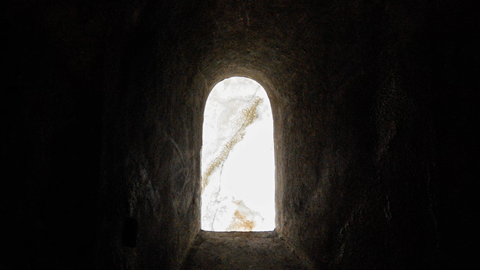Apologists Nick Peters and Joel Furches explore the plausibility of Christianity’s central claim
The holy grail of New Testament studies is the answer to the question of Jesus’ resurrection. Every story and doctrine in the New Testament hinges on this one question. If Jesus rose, then it is most likely the case that his claim to be the Son of God is true. From this it follows that he has conquered sin, ascended to heaven and will come again to judge the living and the dead. If true, the resurrection would also lend weight to the biblical narrative that the world is meant to enter a new creation inaugurated by that self-same resurrection. If, on the other hand, Jesus did not rise from the dead, then he is an interesting figure to study, but his life is little more than a historical curiosity.
This collection of bold claims may seem to be a bit too ambitious. Jewish scholar Pinchas Lapide, for instance, holds that Jesus did rise from the dead, but does not believe he is the Messiah or any of the Christian claims about him. But Lapide seems to stand alone in his approach.
Enough books have been written on the question of the resurrection to fill a library. Many of these books run into the hundreds of pages. This being the case, this article will be a brief overview of the reasons for holding to the doctrine. Consider the resources listed at the end of this article for a more rigorous examination of the question.
Read more:
Was Jesus really crucified?
Why did Jesus have to die for me?
The cross as the ultimate symbol of deconstruction
The greatest story ever told
The copycat hypothesis
As scholarship on ancient cultures and religions has advanced, so has the theory that Jesus just represents one among a multitude of common mythological trends. The virgin birth, the travelling teacher dispensing oracles to groups of disciples and working miracles, and especially the dying and rising god – these parallels have been drawn increasingly commonly in recent years.
The parallels between the resurrection of Jesus and pagan gods need to be dismissed. This became a popular argument when mystery religions first started being a subject of major research, but it is now known that many of these gods either weren’t resurrected in any way, or if they were, these legends began after the Christian movement started. Because of their late date, these stories were more likely influenced by the Jesus tradition rather than the reverse. And given that these stories came about after the advent of Christianity, they could not be the basis for the Gospel stories. Refer to the resources at the end of this article for further information on these objections from mythology.
The biblical case
To examine the case for the resurrection, the first place to go is the New Testament. Not, as one might suppose, directly to the Gospel accounts, but rather to 1 Corinthians 15. The reason for this odd location is that 1 Corinthians 15 includes what is believed to be an early Christian creed. In this creed, Paul spells out the basic points of Jesus’ death, burial and resurrection. Following this outline, Paul goes on to list the eyewitnesses of this event.
1 Corinthians 15 is very evidently a creed. During chapter 15, Paul suddenly begins writing in a different style. Read in its original Greek, the passage has a structure and rhythm typical of an account which was memorised and passed along to others. Part of this structure is the introduction: “What I received, I passed on to you.” But from where, one wonders, did he receive this saying?
Most scholars will date this to within five years of the Easter event, whatever that event may have been. It is believed that Paul learned this creed on his first visit to Jerusalem to meet the apostles: an occasion described in Galatians 1-2. If he learned the creed on this visit, it must have existed beforehand. Paul’s conversion to Christianity likely happened no later than two years after Easter. For all of those reasons, the creed is thought to be extremely early.
Paul’s creed mentions appearances to Peter, to James, the brother of Jesus, to Jesus’ inner circle, to all of the apostles and then to 500 at one time, some of whom had since died. Lastly, Paul mentions himself as an eyewitness. Paul recognises, however, that he was anomalous. Up until then, all of Jesus’ appearances had happened within days of the event. Paul didn’t see Jesus until at least a year later. It is worth noting that Paul’s list includes a total of three mass appearances.
As seen above, the appearance tradition laid out in 1 Corinthians is extremely early. For this reason, New Testament scholars – Christian or otherwise – agree that it is certain the apostles believed they had seen something. One could find scholars on the fringe that might dispute this, but they would be few and far between. Therefore, if that path is followed, what is the cause of this?
Sceptical responses
For those unwilling to take the Bible accounts at face value, the most common explanation is that some or all of Jesus’ followers were victims of hallucination. This theory is problematic insofar as one must be in the proper mindset to have a hallucination. One either must be in a state of mental illness that causes this (of which no evidence exists for the apostles), or one must be in a state of intense grief. Grief seems like a possible reaction for the apostles to have after the crucifixion, but it is also possible that they were in a state of anger. After all, they had spent years following someone and then this is how it ended. Had he misled them?
New Testament scholar NT Wright has also said that this would not convince the disciples that Jesus was alive, but rather that he was dead. Most people who have hallucinations do not decide to go to a graveyard and dig up the body expecting the loved one to be beating on a casket wanting to be released. Hallucinations would more likely be of Jesus in the afterlife, or divinely exalted rather than a flesh and blood person walking among them.
The hallucination theory also does not deal with the empty tomb. If there had been a body in the tomb, then all the hallucinations in the world would not have made a difference. The hallucination theory implies that Jesus was buried in a tomb and that the tomb was not empty. For more on the burial and empty tomb, see the resource list at the end of this article.
Another sceptical approach to the disciple’s belief is cognitive dissonance. Most sceptics who use this approach have never significantly studied the subject of cognitive dissonance (CD). CD occurs when a person’s deeply held beliefs are challenged by contrary evidence. This causes mental distress and the person must relieve this stress by making up a comfortable excuse or explanation.
CD has been known to occur in religious groups, usually when an apocalyptic event is predicted and then fails to happen. However, in most cases where cognitive dissonance takes place, the group tends to grow smaller after the event rather than expand its membership, which is obviously not what happened with Christianity. Also, an easier belief to make up would be divine exaltation – a sort of ‘spiritual resurrection’, in which Jesus’ immortal soul goes to dwell with God. The disciples instead went with a bodily resurrection, which would be the hardest to believe and the easiest to disprove by merely producing the body.
Get access to exclusive bonus content & updates: register & sign up to the Premier Unbelievable? newsletter!
Invention unlikely
While the ancient world may seem superstitious and credulous, they were not keen on the idea of resurrection. This was an idea which was often openly scoffed. It just didn’t happen. The body was seen as a prison to be escaped rather than an immortal vehicle. Why would anyone want to return to their body? Christians, however, taught that this body was good, and that the physical world was equal in value to the spiritual world. If anything, the first heresies of Christianity taught that matter was evil and surely God would not incarnate in a state of material corruption.
Put plainly, the ideas of the early Christians were not likely to spring out of the cultural ideas or trends of the time. No one would simply invent a story of a Messiah which had been shamed and crucified by the ruling powers, much less convert to this scandalous notion. The evidence points toward an unprecedented event, which shattered the conventions of the 1st Century Jewish and pagan traditions. It points to a Messiah who broke all of the rules and convinced an unlikely group of people that he had truly performed the impossible.
Joel Furches is an apologist, journalist and researcher on conversion and deconversion, based in the USA.
Nick Peters has mentored under apologists Michael Licona and Norm Geisler and currently attends seminary, pursuing a degree in philosophy. Nick has Asperger’s Syndrome, a high-function form of autism, which has become a guiding force in his ministry to disabilities within the Church. Nick’s apologetics focus is on the historical Jesus, biblical scholarship and evidence for the resurrection.
If readers wish to know more on this subject, the following resources will be helpful:
· The Case for the Resurrection of Jesus by Gary Habermas and Mike Licona
· The Case for Christ and The Case for the Real Jesus by Lee Strobel
· The Resurrection of Jesus: A New Historiographical Approach by Mike Licona
· The Jesus Inquest by Charles Foster
· The Resurrection of the Son of God by N.T. Wright
· Did Jesus Rise From The Dead, A debate between Gary Habermas and Antony Flew
· The Son Rises by William Lane Craig
· Defending the Resurrection by James Patrick Holding
· Buried Hope Or Risen Savior by Charles Quarles
· Cold-Case Christianity by J Warner Wallace
Topics
- afterlife
- Apologetics
- bible
- Bible: New Testament
- Bible: Old Testament
- body
- Christian living
- christianity
- Church
- cross
- Culture
- death
- dreams
- easter
- empty
- eternity
- God
- God
- gospels
- hallucinations
- heaven
- historical Jesus
- History
- immortal
- immortality
- Jesus
- Jesus
- new body
- proof
- Religious Seasons
- resurrect
- Resurrection
- rise
- sceptic
- scepticism
- soul
- Theology
- tomb























